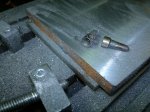I took most of the half term week off and with the weekends before and since real progress is being made.
I am also learning how to make sense of the notes from Mr. Leak, and decided to buy an up-to-date set of plans from Camden… this is all leading towards making progress…
Rear Columns
Firstly to return to the columns – as noted earlier I machined these individually on the milling machine, but eventually concluded that they were not “perfect”. The two columns were about 8-thou different in hight, the tops were not completely orthogonal (about 4thou front to back) and the milling cutter was not completely true, so there were ridges. (here was this intial set up)

First attempt at finishing the columns
I spend a day “getting things true” – resetting the vertical head on the mill to within about 2thou over a 6 inch distance (front to back) and to a similar accuracy over a 10 inch distance left to right. I spent half a day trying to resharpen the flutes on the milling cutters on the Quorn to the desired degree of accuracy, and failed (marked down roller-bearing or air-bearing tool holder as a future necessity – just too much stiction/slop in the current arrangement to do good work). (I will re-create this set up and take a picture later!).

easily done on the shaper – at the limit of the Ram’s throw!
The backs of the columns (air pump slideways etc.) were also finished on the shaper – right at the capacity limit of the wartime, American, lend-lease machine – but as always it produces a really nice finish with simple tools and is quite relaxing to watch too!

finishing the rest of the rear surfaces of the columns
In the end the columns were returned to the miller to have the rest of the “rear” surfaces finished with a flycytter and long-series end mills…
In the spirit of “getting it right” I purchased a new angle plate at the Midlands model engineering show, and then learnt and practised the craft of hand scraping with engineer’s blue to get it flat etc.
Then fitted this angle plate to the side of the shaper (to make a “lower table”) and managed to get the two columns fitted (side by side) onto that with the slideways clamped to the side of the table, and then was able to re-finish the tops of the column. A much more satisfactory finish – no discernible difference in height between the two (phew!)
 the column erection jig in place
the column erection jig in place

trying the rear columns agains the erection jig
You can see them “tested” against the erection jig (adjusted for the over-width main bearings here…
Cylinder Bases
 Then I started on the cylinder bases. A nice return to lathe work! A simple job, first facing off the inside faces, and drilling/boring/reaming the 3/4″ hole for the piston rod, then clamp it face down on the milling table and face the mounting face, and bore for the gland/stuffing box.
Then I started on the cylinder bases. A nice return to lathe work! A simple job, first facing off the inside faces, and drilling/boring/reaming the 3/4″ hole for the piston rod, then clamp it face down on the milling table and face the mounting face, and bore for the gland/stuffing box.

drilling the pilot hole for piston rod in LP cylinder bottom cover fly-cutting the mounting flange on the HP cover

fly-cutting the mounting flange on the HP cover
Soon a pair of nicely finished covers emerged – now the fun begins…. getting to grip with the cylinders…























